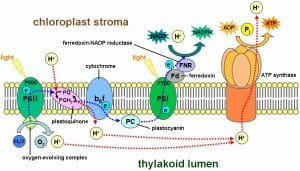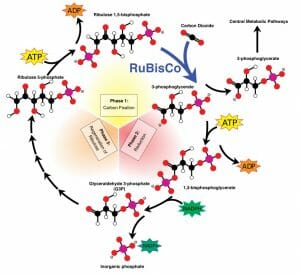Photosynthesis Definition
Photosynthesis is the biochemical pathway which converts the energy of light into the bonds of glucose molecules. The process of photosynthesis occurs in two steps. In the first step, energy from light is stored in the bonds of adenosine triphosphate (ATP), and nicotinamide adenine dinucleotide phosphate (NADPH). These two energy-storing cofactors are then used in the second step of photosynthesis to produce organic molecules by combining carbon molecules derived from carbon dioxide (CO2). The second step of photosynthesis is known as the Calvin Cycle. These organic molecules can then be used by mitochondria to produce ATP, or they can be combined to form glucose, sucrose, and other carbohydrates. The chemical equation for the entire process can be seen below.
Photosynthesis Equation
Above is the overall reaction for photosynthesis. Using the energy from light and the hydrogens and electrons from water, the plant combines the carbons found in carbon dioxide into more complex molecules. While a 3-carbon molecule is the direct result of photosynthesis, glucose is simply two of these molecules combined and is often represented as the direct result of photosynthesis due to glucose being a foundational molecule in many cellular systems. You will also notice that 6 gaseous oxygen molecules are produced, as a by-produce. The plant can use this oxygen in its mitochondria during oxidative phosphorylation. While some of the oxygen is used for this purpose, a large portion is expelled into the atmosphere and allows us to breathe and undergo our own oxidative phosphorylation, on sugar molecules derived from plants. You will also notice that this equation shows water on both sides. That is because 12 water molecules are split during the light reactions, while 6 new molecules are produced during and after the Calvin cycle. While this is the general equation for the entire process, there are many individual reactions which contribute to this pathway.
Stages of Photosynthesis
The Light Reactions
The light reactions happen in the thylakoid membranes of the chloroplasts of plant cells. The thylakoids have densely packed protein and enzyme clusters known as photosystems. There are two of these systems, which work in conjunction with each other to remove electrons and hydrogens from water and transfer them to the cofactors ADP and NADP+. These photosystems were named in the order of which they were discovered, which is opposite of how electrons flow through them. As seen in the image below, electrons excited by light energy flow first through photosystem II (PSII), and then through photosystem I (PSI) as they create NADPH. ATP is created by the protein ATP synthase, which uses the build-up of hydrogen atoms to drive the addition of phosphate groups to ADP.
The entire system works as follows. A photosystem is comprised of various proteins that surround and connect a series of pigment molecules. Pigments are molecules that absorb various photons, allowing their electrons to become excited. Chlorophyll a is the main pigment used in these systems, and collects the final energy transfer before releasing an electron. Photosystem II starts this process of electrons by using the light energy to split a water molecule, which releases the hydrogen while siphoning off the electrons. The electrons are then passed through plastoquinone, an enzyme complex that releases more hydrogens into the thylakoid space. The electrons then flow through a cytochrome complex and plastocyanin to reach photosystem I. These three complexes form an electron transport chain, much like the one seen in mitochondria. Photosystem I then uses these electrons to drive the reduction of NADP+ to NADPH. The additional ATP made during the light reactions comes from ATP synthase, which uses the large gradient of hydrogen molecules to drive the formation of ATP.
The Calvin Cycle
With its electron carriers NADPH and ATP all loaded up with electrons, the plant is now ready to create storable energy. This happens during the Calvin Cycle, which is very similar to the citric acid cycle seen in mitochondria. However, the citric acid cycle creates ATP other electron carriers from 3-carbon molecules, while the Calvin cycle produces these products with the use of NADPH and ATP. The cycle has 3 phases, as seen in the graphic below.
During the first phase, a carbon is added to a 5-carbon sugar, creating an unstable 6-carbon sugar. In phase two, this sugar is reduced into two stable 3-carbon sugar molecules. Some of these molecules can be used in other metabolic pathways, and are exported. The rest remain to continue cycling through the Calvin cycle. During the third phase, the five-carbon sugar is regenerated to start the process over again. The Calvin cycle occurs in the stroma of a chloroplast. While not considered part of the Calvin cycle, these products can be used to create a variety of sugars and structural molecules.
Products of Photosynthesis
The direct products of the light reactions and the Calvin cycle are 3-phosphoglycerate and G3P, two different forms of a 3-carbon sugar molecule. Two of these molecules combined equals one glucose molecule, the product seen in the photosynthesis equation. While this is the main food source for plants and animals, these 3-carbon skeletons can be combined into many different forms. A structural form worth note is cellulose, and extremely strong fibrous material made essentially of strings of glucose. Besides sugars and sugar-based molecules, oxygen is the other main product of photosynthesis. Oxygen created from photosynthesis fuels every respiring organism on the planet.
Quiz
1. To complete the Calvin cycle, carbon dioxide is needed. Carbon dioxide reaches the interior of the plant via stomata, or small holes in the surface of a leaf. To avoid water loss and total dehydration on hot days, plants close their stomata. Can plants continue to undergo photosynthesis?
A. Yes, as long as there is light
B. No, without CO2 the process cannot continue
C. Only the light reaction will continue
2. Why are the products of photosynthesis important to non-photosynthetic organisms?
A. It is the basis of most the energy on Earth
B. They need the minor nutrients assembled by plants
C. They are not important for obligate carnivores
3. Why do plants need water?
A. For photosynthesis
B. For structure
C. To transfer nutrients
D. All of the above
References
- Lodish, H., Berk, A., Kaiser, C. A., Krieger, M., Scott, M. P., Bretscher, A., . . . Matsudaira, P. (2008). Molecular Cell Biology 6th. ed. New York: W.H. Freeman and Company.
- Nelson, D. L., & Cox, M. M. (2008). Principles of Biochemistry. New York: W.H. Freeman and Company.
- Reece, J. B., Urry, L. A., Cain, M. L., Wasserman, S. A., Minorsky, P. V., & Jackson, R. B. (2014). Campbell Biology, Tenth Edition (Vol. 1). Boston: Pearson Learning Solutions.
Photosynthesis


No comments:
Post a Comment